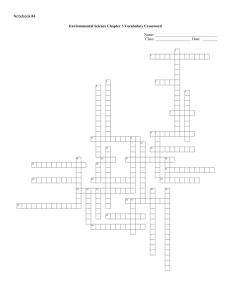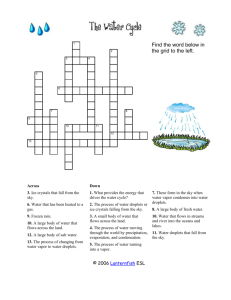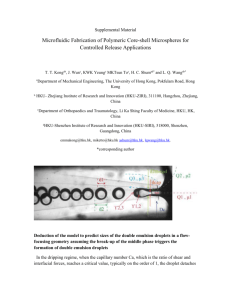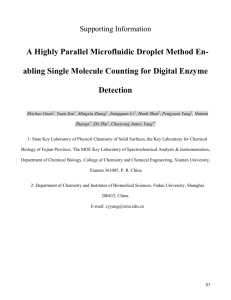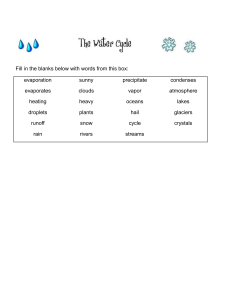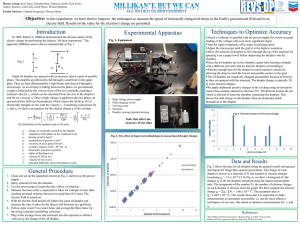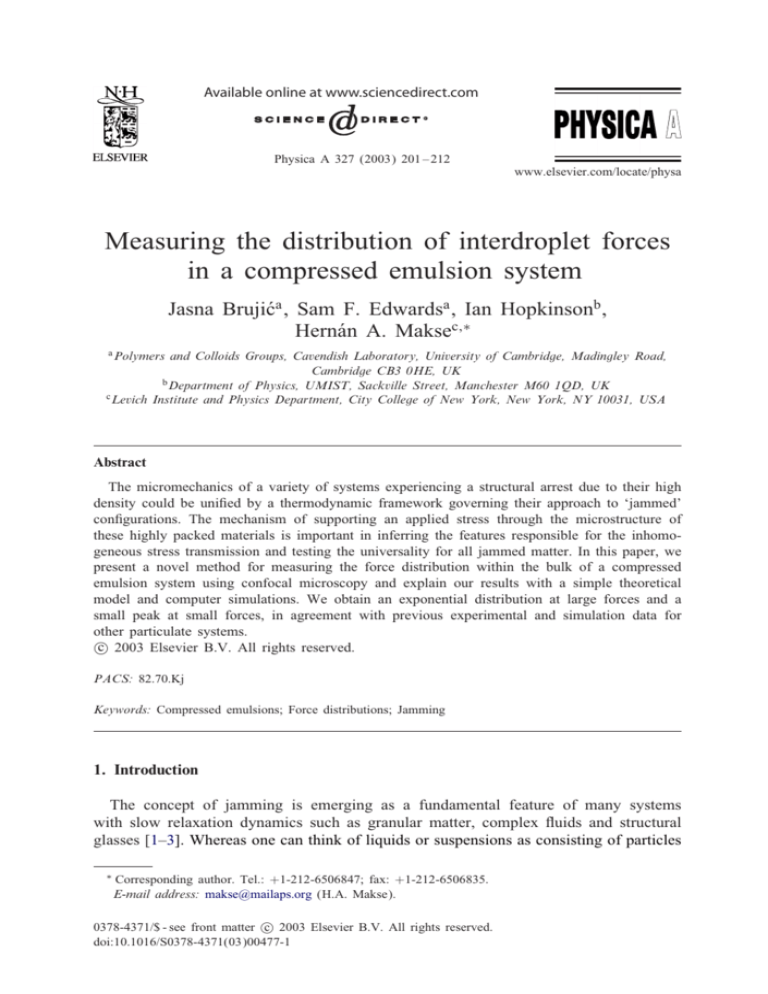
Available online at www.sciencedirect.com
Physica A 327 (2003) 201 – 212
www.elsevier.com/locate/physa
Measuring the distribution of interdroplet forces
in a compressed emulsion system
Jasna Bruji&ca , Sam F. Edwardsa , Ian Hopkinsonb ,
Hern&an A. Maksec;∗
a Polymers
and Colloids Groups, Cavendish Laboratory, University of Cambridge, Madingley Road,
Cambridge CB3 0HE, UK
b Department of Physics, UMIST, Sackville Street, Manchester M60 1QD, UK
c Levich Institute and Physics Department, City College of New York, New York, NY 10031, USA
Abstract
The micromechanics of a variety of systems experiencing a structural arrest due to their high
density could be uni0ed by a thermodynamic framework governing their approach to ‘jammed’
con0gurations. The mechanism of supporting an applied stress through the microstructure of
these highly packed materials is important in inferring the features responsible for the inhomogeneous stress transmission and testing the universality for all jammed matter. In this paper, we
present a novel method for measuring the force distribution within the bulk of a compressed
emulsion system using confocal microscopy and explain our results with a simple theoretical
model and computer simulations. We obtain an exponential distribution at large forces and a
small peak at small forces, in agreement with previous experimental and simulation data for
other particulate systems.
c 2003 Elsevier B.V. All rights reserved.
PACS: 82.70.Kj
Keywords: Compressed emulsions; Force distributions; Jamming
1. Introduction
The concept of jamming is emerging as a fundamental feature of many systems
with slow relaxation dynamics such as granular matter, complex :uids and structural
glasses [1–3]. Whereas one can think of liquids or suspensions as consisting of particles
∗
Corresponding author. Tel.: +1-212-6506847; fax: +1-212-6506835.
E-mail address: makse@mailaps.org (H.A. Makse).
c 2003 Elsevier B.V. All rights reserved.
0378-4371/$ - see front matter doi:10.1016/S0378-4371(03)00477-1
202
J. Bruji4c et al. / Physica A 327 (2003) 201 – 212
which move very slowly compared to gases, there comes a point where all particles
are in close contact with one another and, therefore, experience structural arrest. In
granular systems and compressed emulsions there is no kinetic energy of consequence;
the typical energy required to change the positions of the jammed particles is very
large compared to the thermal energy at room temperature. As a result, the material
remains arrested in a metastable state and is able to withstand an applied stress [4].
There is a growing literature studying the ‘jammed’ state in particulate assemblies,
aiming to characterise its micromechanics [1]. It has been shown experimentally that
the stresses are distributed inhomogeneously through granular materials and the features of the distribution are useful in inferring the structural elements associated with
mechanisms of supporting the applied stress. In order to develop a theory to describe
such closely packed particles, one needs to know the geometry of the packing in the
bulk and the distribution and propagation of stress in these systems.
Several approaches have so far been employed, including two-dimensional (2D) and
three-dimensional (3D) experimentation [5,6], numerical simulations [7–11] and statistical modelling [12]. Previous experiments in 3D assemblies have been con0ned to
measurements of the probability distribution of forces exerted at the boundaries with the
container, thus reducing the dimensionality of the problem [6,13–15,9]. These measurements provide a quantitative understanding of the inhomogeneity of stress transmission
within the bulk. However, the method does not have access to the spatial arrangement
of the contact force network and other structural features, such as force chains and
arching, which have been postulated as the signature of jamming [1,11].
The salient feature of the probability distribution P(f) of interparticle contact force
f in jammed systems, obtained from the above methods, is an exponential decay
above the mean value of the force. This feature of P(f) seems very robust, with
growing evidence that it is independent of particle rigidity [7,10], crystallinity [15],
tangential forces, construction history and friction [9]. Nevertheless, there is no clear
consensus on the general functional form of P(f) as there are signi0cant discrepancies
in the literature particularly regarding the behaviour at small forces, both between
experimental data and the theoretical model predictions. Moreover, the possibility of a
crossover to a Gaussian-like distribution has been observed at large con0ning pressures
[8,9,16].
In this paper, we present a novel method to measure the force distribution within
a concentrated emulsion system in its jammed state, which provides the complete 3D
information of the contact force network and the spatial arrangement of droplets. We
address this problem using confocal microscopy, which provides direct measurement of
the dispersed phase morphology within the bulk of the sample. An emulsion consists of
one :uid dispersed in another (usually oil in water), stabilised by a surfactant to reduce
the interfacial tension. The surface tension ensures that the droplets are spherical in
shape, unless they are forced to deform by geometric constraints. The emulsion droplets
are compressed by an external pressure through centrifugation because of the density
diIerence between the phases, and a force network develops within the system in response to the applied stress. At high volume fractions, above the random close packing
regime, emulsions exhibit an elasticity which is rationalised by the storage of energy
through the deformation of droplets, given in terms of their Laplace pressure [17].
J. Bruji4c et al. / Physica A 327 (2003) 201 – 212
203
The degree of deformation is used to derive an interdroplet force. The interaction
potential between droplets is considered to be purely repulsive, since there is no spontaneous deformation of droplets if uncompressed (as shown in Fig. 1(a)). Moreover,
the droplet deformation upon compression is fully and spontaneously reversible on
removal of the external force. The 3D imaging of a whole ensemble allows the calculation of the repulsive forces between the droplets, thus enabling the determination of
P(f). We 0nd that the distribution is characterised by a small peak at low forces and
an exponential decay at forces above the mean value, a result that can be described
by the functional form of P(f) derived from the simple theoretical model we propose
in this paper.
The form of the probability distribution is independent of the material of the particle
provided it has well-de0ned elastic properties. Therefore, we can expect the micromechanics of an emulsion, comprised of comparatively ‘soft’ particles, to bear many
similarities with a packing of granular materials, such as ball bearings or glass beads.
Even though there have been no studies of P(f) speci0cally devised for compressed
emulsion systems, we compare our results with the existing data for other jammed
systems such as grains and foams, thus testing the hypothesis of a common behaviour
for all such matter.
We use numerical simulations to examine the eIect of polydispersity, osmotic
pressure, and other microstructural features, such as the coordination number, on the
distribution of forces. They are designed to mimic the experimental procedure on
monodisperse and polydisperse distributions of soft particles. The numerical simulation result at the appropriate con0ning pressure and the same polydispersity as in the
experiment, is in good agreement with that obtained from the experiment.
Moreover, we oIer in this paper what we believe is the simplest realistic theory
of the force distribution, a theory which does not attempt the ambitious study of the
percolation of forces [18], but has the advantage of a simple analytic solution. The
theory is suKciently crude that the reader will be able to see all sorts of ways in
which it can be improved; however, the simple prediction of the theory can easily be
compared to experimental results and is found to describe the data well.
2. Experiment
We use a Zeiss LSM510 confocal laser scanning microscope equipped with a high
numerical aperture oil-immersion objective lens with a 40× magni0cation. The :uorescent dye is excited with a 488 nm Argon laser and the emitted light is detected using a
photomultiplier behind a long-pass 505 nm 0lter. These settings are appropriate for the
excitation of Nile Red dye, used to label the emulsion described below [see Ref. [19]
for more details]. The sample volume (76:3 × 76:3 × 23:6 m3 ) is typically acquired
from regions 30 m below the upper surface of the sample. In this work, a 3D image
is acquired in approximately 2 min.
The emulsion system constitutes of silicone oil droplets in a refractive index matching
solution of water (wt = 50%) and glycerol (wt = 50%), stabilised by 10 mM sodium
dodecylsulphate (SDS).
204
J. Bruji4c et al. / Physica A 327 (2003) 201 – 212
(a)
(b)
(c)
Fig. 1. 2D slices of emulsions under varying compression rates: creaming under gravity (a), 6000 rpm
(b) and 8000 rpm (c).
This system is a modi0cation of the emulsion reported by Mason et al. [20] to
produce a transparent sample suitable for confocal microscopy. It ensures a purely
repulsive interaction potential between the droplets, as the surfactant concentration is
only slightly above the critical micellar concentration, thus avoiding any depletion
attractions.
The droplet size distribution, measured by image analysis, gives a mean radius of
3:4 m with a radius range between 1 and 10 m. This relatively narrow droplet size
distribution is achieved by applying high shear rates (7000 s−1 ) to a coarsely mixed
parent emulsion using a Linkam shear stage [21]. To provide contrast between the
phases in the microscope, the dispersed oil phase is :uorescently labelled by adding
0.1 mM solution of Nile Red dye, predissolved in acetone. The emulsion system prepared in this way remains stable to coalescence for at least 1 year.
The threshold volume fraction for the onset of elasticity depends on the polydispersity of the emulsion, or in other words, the eKciency of the packing. The sequence
of images in Fig. 1 shows 2D slices from the middle of the sample volume after:
(a) creaming under gravity, (b) centrifugation at 6000 rpm for 20 min and (c) centrifugation at 8000 rpm for 20 min. The samples were left to equilibrate for several
hours prior to measurements being taken. The volume fraction at the onset of droplet
deformation for our polydisperse system is = 0:90, determined by image analysis.
This high volume fraction obtained at a relatively small osmotic pressure of 125 Pa
is achieved due to the polydispersity of the sample, which enables a more eKcient
packing density.
Confocal imaging of the static sample revealed an eIect which occurs upon emulsion
compression. The areas of contact between the droplets :uoresce with a higher intensity
than the undeformed perimeters on the bodies of the droplets, thus highlighting the
regions of interest. Images presented in Fig. 1 illustrate this trend as the osmotic
pressure is increased. Future work will involve a more thorough investigation of this
eIect.
2.1. The force model
The interdroplet forces are considered to be purely repulsive, since the droplets do
not aggregate in dilute solution and do not deform when in contact, unless a suKciently
J. Bruji4c et al. / Physica A 327 (2003) 201 – 212
205
large external force compresses them beyond their random close-packing con0guration,
i.e., their maximum density. The forces between the droplets are calculated from the 3D
images (of size 256 × 256 × 64 voxels) by means of existing interdroplet force models,
which are based on geometric considerations of droplet deformation away from their
spherical shape. We extract the positions and radii of all the droplets with subvoxel
accuracy using a Fourier 0ltering method (FFM) [19,22]. The areas of contact patches
shown in Fig. 1(b) are extracted based on an intensity threshold, since they are brighter
than either the droplets or the aqueous background.
The determination of an accurate force model for the compression of two droplets
is not trivial, but can be simpli0ed within certain limits. For small deformations with
respect to the droplet surface area, the Laplace pressure remains unchanged and all the
energy of the applied stress is presumed to be stored in the deformation of the surface.
Hence, at the microscopic level, two spherical droplets in contact with radii R1 and R2
interact with a normal force [17]
(1)
f= A;
R̃
where A is the area of deformation, is the interfacial tension of the droplets and R̃
is the geometric mean of the radii of the undeformed droplets, R̃ = 2R1 R2 =(R1 + R2 ).
The normal force acts only in compression.
The above force corresponds to an energy of deformation which is quadratic in the
area of deformation, analogous to a harmonic oscillator potential that describes a spring
satisfying Hooke’s law [23]. There have been several more detailed calculations [24]
and numerical simulations [25] to improve on this model and allow for anharmonicity
in the droplet response by also taking into consideration the number of contacts by
which the droplet is con0ned. Typically, these improved models lead to a force law for
small deformations of the form f˙A , where is a coordination number-dependent
exponent in the range 1–1.5. Nevertheless, this work assumes the simple model, the
validity of which was tested by the summation of all the forces on a single droplet.
Since the sum on each droplet could be approximated to zero we consider the method
adequate.
2.2. Experimental results
Fig. 2 shows the probability distribution of interdroplet forces, P(f), for the sample
shown in Fig. 1(b). We use the force model (Eq. (1), = 9:8 × 10−3 N=m [20])
to obtain the interdroplet forces from the contact area data extracted from the image
analysis described above.
The forces are calculated from the bright, :uorescent patches that highlight the contact areas between droplets. The radii of the droplets needed to obtain the forces
according to Eq. (1) are obtained with the FFM. The distribution data shown are extracted from 1234 forces arising from 450 droplets. The data show an exponential
distribution at large forces, consistent with results of many previous experimental and
simulation data on granular matter, foams, and glasses. The behaviour in the low-force
regime indicates a small peak, although the power law decay tending towards zero is
206
J. Bruji4c et al. / Physica A 327 (2003) 201 – 212
1
0.9
P(x)=3.7x exp(-1.9x)
Patch Data
P(f/<f>)
0.1
0.01
0.001
0
1
2
3
4
5
f/<f>
Fig. 2. Probability distribution of the contact forces for the compressed emulsion system shown in Fig. 1(b).
We also show a 0t to the theory developed in Section 3.
not well pronounced. The best 0t to the data gives a functional form of the distribuR
tion P(f) ˙ f0:9 e−1:9f=f , consistent with the theoretical model proposed in Section 3
and the existing literature [12]. It is inappropriate to draw conclusions on the physical
signi0cance of these coeKcients, since the geometry of the packing in the experiment
is very diIerent to our simple theoretical model.
Our experimental data allows us to examine the spatial distribution of the forces in
the compressed emulsion, shown in Fig. 3. In this admittedly small sample volume,
the forces appear to be uniformly distributed in space and do not show evidence of
localisation of forces within the structure. Moreover, we 0nd that the average stress is
independent of direction, indicating isotropy. Other experiments are underway to probe
the existence of force chains in compressed emulsion systems.
3. Theory
Although the experimental system consists of polydisperse particles which are deformable, in order to get a tractable theory, we simply consider spheres in multiple
contact greater than or equal to four in 3D. Even though this is a gross simpli0cation
we believe that a theory that can be carried through to an analytic solution is worthwhile. The geometric constraints are appropriate for comparison with the experimental
system in that these coordination numbers describe a jammed system of hard grains,
which we believe is the unifying concept in this study. It has already been postulated
by O’Hern et al. (2001) that the functional form of the probability distribution of the
forces which uni0es the behaviour of many systems far from equilibrium arises at the
point at which these systems experience a structural arrest. The reader is referred to
J. Bruji4c et al. / Physica A 327 (2003) 201 – 212
207
Fig. 3. Plot of the interdroplet forces inside the packing of droplets. We plot only the forces larger than the
average for better visualisation. Each rod joining the centers of two droplets in contact represents a force.
The thickness and the colour of the rod is proportional to the magnitude of the force, as obtained from the
area of contact using Eq. (1). Lengths are in m and forces in nN.
more comprehensive theories such as the q-model [12] or force-splitting models [18]
for more detailed theoretical analysis, which are correspondingly more diKcult to solve.
By Newton’s laws, in equilibrium the sum of all the forces exerted on a particle
by its nearest neighbours is zero. In three dimensions, the average shape of a particle
is a sphere, and the minimum co-ordination number N is 4 [26,9]. Consequently, the
force f̃ exerted by a particle on one of its neighbours will equal the sum of the forces
f̃ 1 + f̃ 2 + f̃ 3 of the other neighbours in contact with it. To simplify we consider
the scalar f = |f̃| since it will have a very similar distribution on every grain. The
distribution of the vector f̃ will diIer even on adjacent grains, therefore we calculate
P(f), not P(f̃). It is important to note that only those forces which are pushing on
each particle are taken into account in the calculation of P(f), a fact which will appear
in the range of integration.
Our model takes into account the direction cosines of each of the forces. Excluded
volume is also an important factor as particles cannot overlap and the four particle force
correlation function should be included. All these eIects can be crudely modelled by
blurring the contribution from each of the pushing forces by a factor i ∈ [0; 1] (i =
1; 2; 3), which plays the role of the direction cosine and the other correlation factors.
208
J. Bruji4c et al. / Physica A 327 (2003) 201 – 212
A force balance equation which is capable of analytic solution is
f = 12 f1 + 22 f2 + 32 f3 :
(2)
This gives rise to an equation of the Boltzmann form
1
∞
P(f) =
df1 df2 df3
d1 d2 d3 (f − 12 f1
0
0
−22 f2 − 32 f3 )P(f1 )P(f2 )P(f3 ) :
(3)
It is convenient
to work with the Fourier transform of the probability distribution
∞
P(k) = −∞ eikf P(f) df which gives
3
1
2
dP( k) ;
(4)
P(k) =
0
which can be solved to give the normalised distribution
2 f1=2 −f=p
;
e
P(f) = √
p3=2
(5)
where p ˙ fR and the proportionality constant depends on the exponent of the power
law rise at low forces. More generally, if there are N contacts arising from diIering
geometric con0gurations, similar calculations give
P(f) ˙ f1=(N −2) e−f=p :
(6)
Note that for a large number of contacts, P(f) reaches zero very near f = 0. In
Fig. 2, we see a comparison between the theoretical form and the experimental data
in good agreement. There are many improvements which are essential for belief in
coeKcients, but the functional form, starting at zero and ending with an exponential
decay, seems well founded.
4. Simulations
We perform molecular dynamics (MD) simulations to gain insight into the eIects
of osmotic pressure, polydispersity, and other microstructural features such as the
coordination number and force chains on the probability distribution, P(f). The numerical protocol is designed to mimic the experimental procedure used to prepare
compressed emulsion systems at diIerent osmotic pressures, described in Section 2.
Our model considers an assembly of deformable spherical droplets interacting via repulsive normal forces given by the Princen model in Eq. (1). The continuous liquid
phase is modelled in its simplest form, as a viscous drag force acting on every droplet,
proportional to its velocity. The dynamical evolution of the droplets is obtained by
solving Newton’s equation for an assembly constrained by a given osmotic pressure.
Our model is similar to the discrete element method (DEM) [9,27] used in MD simulations of granular materials. However, we adjust the DEM for the system of compressed
emulsions by exclusion of transversal forces (tangential elasticity and Coulomb friction)
J. Bruji4c et al. / Physica A 327 (2003) 201 – 212
209
and by computation of interparticle forces using the principles of interfacial mechanics described by the Princen model instead of the Hertz model, often used in contact
mechanics of solid particles (f ∼ 3=2 , where is the particle deformation).
The simulations begin with a set of non-overlapping 2000 spherical droplets located
at random positions in a periodically repeated cubic cell of side L. At the outset, a series
of strain-controlled isotropic compressions and expansions are applied until a volume
fraction slightly below the critical density of jamming is reached [9]. The system is
then compressed and extended slowly until a speci0ed value of the stress and volume
fraction is achieved at static equilibrium. The distribution of forces within the static
structure is calculated and then directly compared to that obtained from experiments
and theory.
We 0rst consider a quasi-monodisperse system composed of 1000 droplets of radius 1:05 m and 1000 droplets of radius 0:95 m. Then the eIect of polydispersity
is investigated by consideration of the radii distribution obtained from our experiments
characterized by a Gaussian distribution with a mean value R = 3:4 m and standard deviation 1:44 m and a distribution range between 1 and 6:6 m. The osmotic
pressure, , is varied between 1 Pa and 1 kPa, again mimicking the experiments.
Fig. 4 shows the results of the simulations. We see that the simulated data for
monodisperse and polydisperse systems at low osmotic pressure agrees with the experiments and the theory. At low pressures, the system is close to jamming (near RCP at
∼ 0:64) and the average coordination number is close to its minimal value N = 6
for particles interacting by normal forces only as given by constraint arguments [9,26].
At large pressures, when the coordination number signi0cantly departs from its minimal value, the probability distribution departs from the prediction of the theory and
crosses-over to a Gaussian-like distribution in the case of the monodisperse system [9].
In the case of the polydisperse system, the distribution at large pressures departs from
the exponential decay at large forces, but its form cannot be 0tted by a Gaussian-like
distribution.
The numerical simulation performed under the same conditions as in the experiment yields a P(f) of the same functional form for the appropriate osmotic pressure
( ∼ 100 Pa) and polydispersity (Fig. 4b), although the 0tting coeKcients obtained numerically do not correspond to those obtained experimentally. Moreover, the monodisperse system shows similar results as long as the system is at low osmotic pressure.
Our results indicate that the signi0cant feature is not the detail of the system, but its
proximity to the jamming transition.
5. Discussion and conclusions
We have presented experimental data showing the force distribution in three dimensions of a lightly compressed emulsion, close to the jamming transition. These data
show an exponential distribution of interdroplet forces P(f) at large f. At low f, a
peak in the distribution function is observed. We have 0tted the experimental data with
R
a function of the form P(f) ˙ f0:9 e−1:9f=f suggested by the simple theoretical model
proposed for such a system. In addition we have carried out simulations to determine
210
J. Bruji4c et al. / Physica A 327 (2003) 201 – 212
1
10
Π=1 Pa, <N>=6
Π=10 Pa, <N>=6.3
Π=100 Pa, <N>=7.25
Π=1 kPa, <N>=9.66
0.9
P(x) ~ x exp(-1.9 x)
2
P(x) ~ exp[-(x-0.85 )]
0
P(f/<f>)/P(1)
10
-1
10
-2
10
-3
Monodisperse
10
10
-4
0
1
2
3
4
5
6
f/<f>
(a)
1
10
Π=10 Pa, <N>=5.95
Π=100 Pa, <N>=7.2
Π=1 kPa, <N>=10.9
1/2
P(x) ~ x exp(-1.5 x)
0
P(f/<f>)/P(1)
10
-1
10
-2
10
-3
10
Polydisperse
10
(b)
-4
0
2
4
6
8
f/<f>
Fig. 4. Numerical results for P(f) for a system of (a) monodisperse and (b) polydisperse emulsions at
diIerent osmotic pressure, , and mean coordination number N .
the eIect of polydispersity and osmotic pressure on the force distribution function and
these results are in good agreement with the experimental data. They indicate that the
P(f) is not sensitive to polydispersity, however the exponential decay only 0ts the
data well in distributions close to ‘jamming’, at low con0ning pressures. The theoretiR
cal model predicts a general distribution of the form P(f) ˙ fn e−(n+1)f=f , where the
power law coeKcient n is determined by the packing geometry of the system. It is too
J. Bruji4c et al. / Physica A 327 (2003) 201 – 212
211
crude a model to account for the complexity of the emulsion system, and it is therefore
inappropriate to draw conclusions from direct comparisons of the coeKcients obtained
from theory with those arising from experimental and simulation data. Nevertheless,
the agreement in the functional form for all three methods is an important result. Curiously, we observe that the 0tting coeKcients agree for the experimental data, the
2D theoretical model and the quasi-monodisperse emulsion system at a comparable
pressure to the experiment.
In the future, we hope to determine the mechanism by which the contact patches
between droplets exhibit enhanced :uorescence and also to use the experimental data to
test the validity of various force models for compressible droplets. In the experimental
section, we used the Princen model to obtain the interdroplet force from the contact
area between particles. However, in principle, we should be able to extract the force law
from the data. This study gives supporting evidence to the universality of the concept of
jamming and provides a very reliable experimental way of investigating microstructural
elements within the bulk of any refractive index matched, closely packed system of an
appropriate size.
Acknowledgements
We thank M. Shattuck for introducing us to the particle 0nding algorithm, D. Bruji&c
for help with its implementation and S. Mistry, D. Grinev, J. Bibette and R. Blumenfeld
for inspirational discussions. We are grateful to the EPSRC for supporting this work.
H.M. is supported by NSF DMR-0239504, Materials Theory.
References
[1] A. Liu, S.R. Nagel (Eds.), Jamming and Rheology: Constrained Dynamics on Microscopic Scales,
Taylor & Francis, London, 2001.
[2] S.F. Edwards, D. Grinev, Adv. Complex Systems 4 (2001) 1.
[3] V. Trappe, V. Prasad, L. Cipelletti, P.N. Segre, D.A. Weitz, Nature 41l (2001) 772.
[4] M.E. Cates, J.P. Wittmer, J.-P. Bouchaud, P. Claudin, Chaos 9 (1999) 511.
[5] P. Dantu, G&eotechnique 18 (1968) 50.
[6] C.H. Liu, S.R. Nagel, D.A. Schechter, S.N. Coppersmith, S. Majumdar, O. Narayan, T.A. Witten,
Science 269 (1995) 513.
[7] F. Radjai, M. Jean, J. Moreau, S. Roux, Phys. Rev. Lett. 77 (1996) 274.
[8] C. Thornton, KONA Powder Particle 15 (1997) 81.
[9] H.A. Makse, D.L. Johnson, L.M. Schwartz, Phys. Rev. Lett. 84 (2000) 4160.
[10] S.J. Antony, Phys. Rev. E 63 (2001) 011 302.
[11] C.S. O’Hern, S.A. Langer, A.J. Liu, S.R. Nagel, Phys. Rev. Lett. 86 (2001) 111.
[12] S.N. Coppersmith, C.-H. Liu, S. Majumdar, O. Narayan, T.A. Witten, Phys. Rev. E 53 (1995) 4673.
[13] D.M. Mueth, H.M. Jaeger, S.R. Nagel, Phys. Rev. E 57 (1998) 3164.
[14] G. Lovoll, K.N. Maloy, E.G. Flekkoy, Phys. Rev. E 57 (1999) 5872.
[15] D.L. Blair, N.W. Mueggenburg, A.H. Marshall, H.M. Jaeger, S.R. Nagel, Phys. Rev. E 63 (2001)
041 304.
[16] M.G. Sexton, J.E.S. Socolar, D.G. SchaeIer, Phys. Rev. E 60 (1999) 1999.
[17] H.M. Princen, J. Colloid Interface Sci. 91 (1983) 160.
[18] J.-P. Bouchaud, P. Claudin, D. Levine, M. Otto, Eur. J. Phys. E 4 (2001) 451.
212
J. Bruji4c et al. / Physica A 327 (2003) 201 – 212
[19] J. Bruji&c, S.F. Edwards, D.V. Grinev, I. Hopkinson, D. Bruji&c, H.A. Makse, Faraday Disc. 123 (2003)
207.
[20] T.G. Mason, J. Bibette, D.A. Weitz, Phys. Rev. Lett. 75 (1999) 2051.
[21] T.G. Mason, J. Bibette, Langmuir 13 (1997) 4600.
[22] J.R. Parker, Algorithms for Image Processing and Computer Vision, Wiley, New York, Chichester,
1997.
[23] F. Bolton, D. Weaire, Phys. Rev. Lett. 65 (1990) 3449.
[24] D.C. Morse, T.A. Witten, Europhys. Lett. 22 (1993) 549.
[25] M.-D. Lacasse, G.S. Grest, D. Levine, T.G. Mason, D.A. Weitz, Phys. Rev. Lett. 76 (1996) 3448.
[26] S.F. Edwards, D.V. Grinev, Phys. Rev. Lett. 82 (1999) 5397.
[27] P.A. Cundall, O.D.L. Strack, G&eotechnique 29 (1979) 47.


